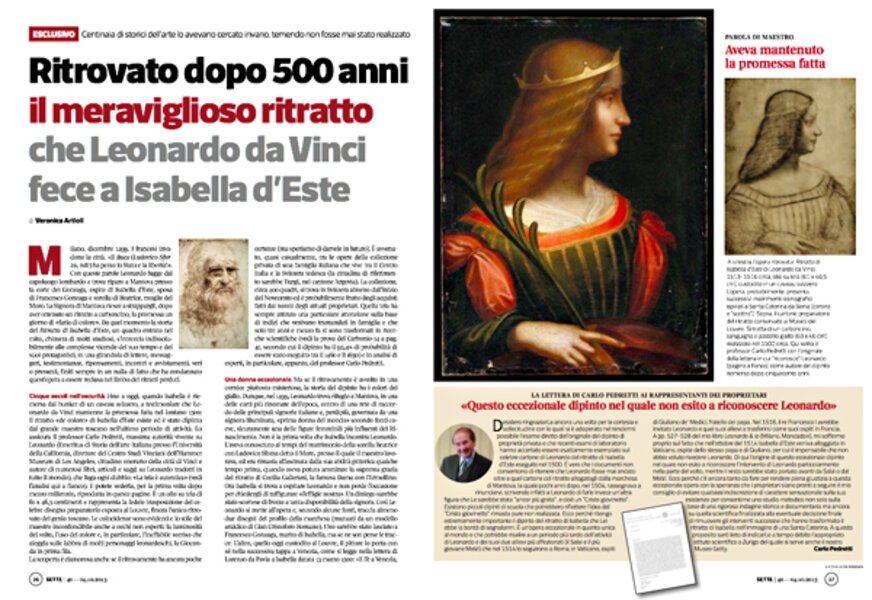Another Da Vinci mystery: Is a newfound 500-year-old painting his?
Loading...
| Rome
The steady gaze and beatific smile are reminiscent of the world’s best known painting, the Mona Lisa.
Those clues, along with carbon dating and other scientific tests, have led Italian experts to claim that they have found the holy of holies of the art world: a previously unknown Leonardo da Vinci masterpiece.
Experts believe that the newly discovered painting is the full-blown, oil version of a pencil sketch drawn by Leonardo of a Renaissance noblewoman, Isabella d’Este, which now hangs in the Louvre Museum in Paris.
Leonardo completed the sketch when he was staying in the city of Mantua, in the northern Lombardy region, in 1499 or 1500.
Pleased with her portrait, the Marquesa d’Este then sent letters asking him to produce a new, more elaborate version in colored oils. According to historical records, she never received a reply.
Art historians speculated that the Renaissance master had moved on to grander, more lucrative commissions, including the Mona Lisa, which is believed to be a portrait of Lisa Gherardini, the young wife of a rich Florentine merchant.
Now, it appears, Leonardo did indeed paint the oil portrait, perhaps when he met d’Este, one of the most influential female figures of her day, in Rome in 1514.
The oil painting was discovered recently in a Swiss bank vault, part of a collection of 400 works owned by an Italian family who have asked not to be identified.
Measuring 24 inches by 18 inches, it bears a striking resemblance to the Leonardo sketch held by the Louvre – the woman’s posture, her hairstyle, her striped dress, and the way she holds her hands are almost identical.
“There are no doubts that the portrait is the work of Leonardo,” Carlo Pedretti, a professor emeritus of art history and an expert in Leonardo studies at the University of California, Los Angeles, told Corriere della Sera newspaper on Friday. “I can immediately recognize Da Vinci's handiwork, particularly in the woman's face."
Scientific tests have shown that the type of pigment in the portrait was the same as that used by Leonardo, as was the primer used to treat the canvas. Carbon dating, conducted by a mass spectrometry laboratory at the University of Arizona, has shown that the portrait was painted between 1460 and 1650.
Professor Pedretti, a recognized expert in authenticating disputed works by Da Vinci, said more analysis was required to determine whether certain elements of the portrait – notably a golden tiara on the noblewoman’s head and a palm leaf held in her hand like a scepter – were the work of Leonardo or one of his pupils.
But as with any new-Leonardo-da-Vinci-discovered story, doubts were expressed by some eminent experts.
Martin Kemp, professor emeritus of the history of art at Oxford University, and one of the world’s foremost authorities on da Vinci, said if the find was authenticated it would be worth “tens of millions of pounds” but raised doubts about whether the painting was really the work of Leonardo.
The portrait found in Switzerland is painted on canvas, whereas Leonardo favored wooden boards, he said.
And Leonardo gave away his original sketch to the marquesa, so he would not have been able to refer to it later in order to paint a full oil version.
It was more likely to have been produced by one of the many artists operating in northern Italy who copied Leonardo’s works. "They'd take a Madonna head from one work and then pick the figure of John the Baptist from another, and produce a sort of pastiche. It was a sort of early version of Photoshop," he says.
Only around 15 works have been reliably attributed to Leonardo, including the Mona Lisa, which is also hangs in the Louvre.
If these latest claims are backed up by other leading da Vinci experts, that number has just jumped to 16.








